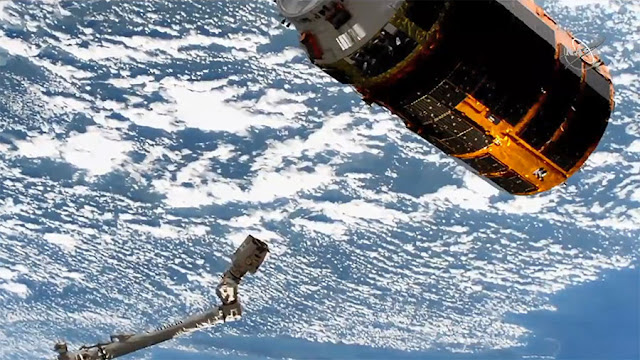JAXA - H-II Transfer Cargo Vehicle 9 (HTV-9) patch.
August 18, 2020
Eleven years after the launch of the first H-II Transfer cargo vehicle (HTV) to the International Space Station, the Japan Aerospace Exploration Agency’s (JAXA’s) HTV-9 departed the orbital laboratory today at 1:36 p.m. EDT.
Image above: Japan’s HTV-9 resupply ship is on its own after being released from the Canadarm2 robotic arm completing a three-month cargo mission at the station. Image Credit: NASA TV.
Earlier today, flight controllers operating from NASA’s Mission Control Center at the agency’s Johnson Space Center in Houston used the space station’s Canadarm2 robotic arm to detach the cargo spacecraft from the station’s Harmony module, then moved the spacecraft into its release position. Expedition 63 Commander Chris Cassidy of NASA used the Canadarm2 robotic arm to release the spacecraft from the station at 1:35 p.m., ending its three-month stay.
HTV-9 departure
This was the final station departure of JAXA’s first-generation Kounotori, or “white stork,” cargo craft, nine of which have delivered more than 40 tons of supplies to space station crews. JAXA is developing a new fleet of HTV cargo craft, the HTV-X, which is targeted for its first launch in 2022.
The spacecraft launched from the Tanegashima Space Center in Japan on May 20, arriving May 25 to deliver about four tons of supplies and experiments to the orbital complex, including new lithium-ion batteries that were used to upgrade the station’s power systems. The new-technology batteries were installed through a series of spacewalks along the far port truss “backbone” of the station.
Image above: In this image, the versatile Canadarm2 robotic arm is poised to grapple and remove the HTV-9 resupply craft from the Harmony module. Station Commander and NASA astronaut Chris Cassidy will command the Canadarm2 to release the HTV-9. The HTV-9 arrived at the station on May 25, 2020, delivering four tons of new science experiments, station hardware, crew supplies and fuel. Image Credit: NASA.
HTV-9 will be commanded by JAXA flight controllers at its HTV control center in Tsukuba, Japan, to move away from the station and, on Aug. 20, to fire its deorbit engine in a burn that will send it back into Earth’s atmosphere. Loaded with trash from the space station, the spacecraft will burn up harmlessly over the Pacific Ocean.
For nearly 20 years, astronauts have continuously lived and work on the space station, testing technologies, performing science and developing the skills needed to explore farther from Earth. As a global endeavor, 240 people from 19 countries have visited the unique microgravity laboratory that has hosted more than 3,000 research and educational investigations from researchers in 108 countries and areas.
Related links:
Expedition 63: https://www.nasa.gov/mission_pages/station/expeditions/expedition63/index.html
Canadarm2 robotic arm: https://www.nasa.gov/mission_pages/station/structure/elements/mobile-servicing-system.html
Space Station Research and Technology: https://www.nasa.gov/mission_pages/station/research/overview.html
International Space Station (ISS): https://www.nasa.gov/mission_pages/station/main/index.html
Images (mentioned), Video, Text, Credits: NASA/Mark Garcia/NASA TV/SciNews.
Best regards, Orbiter.ch



